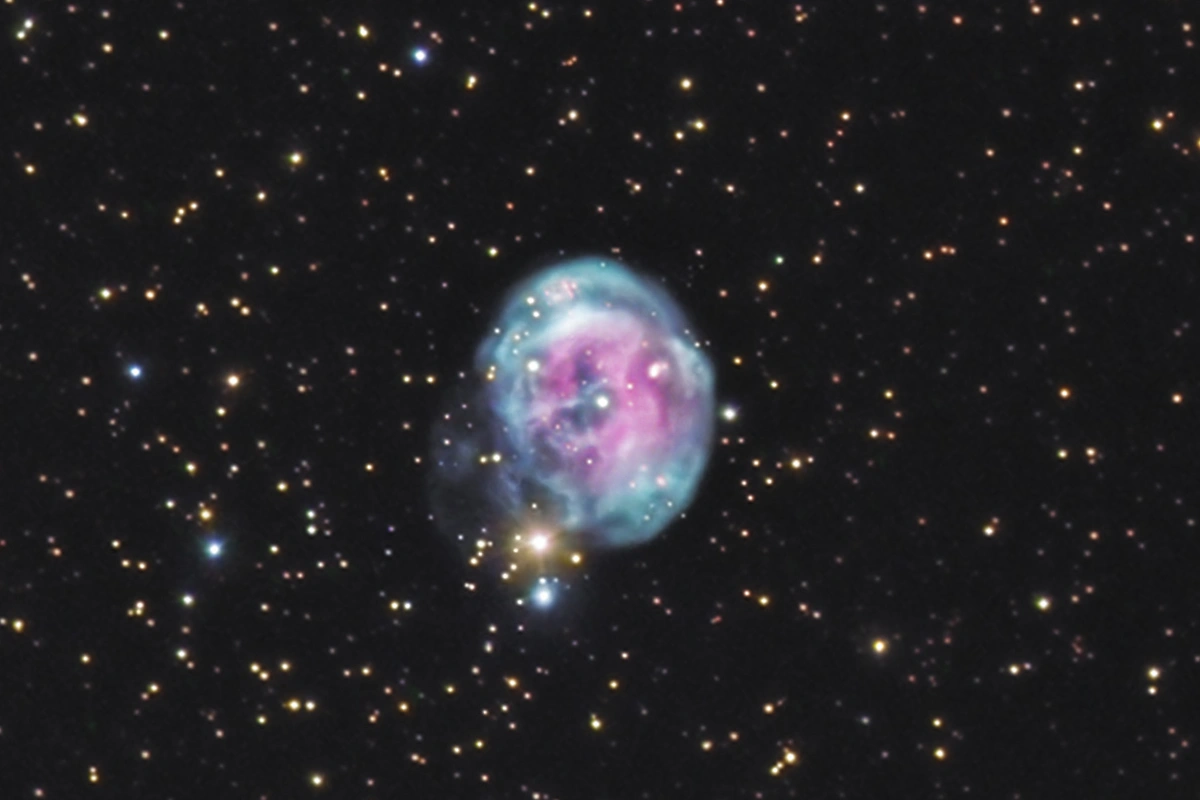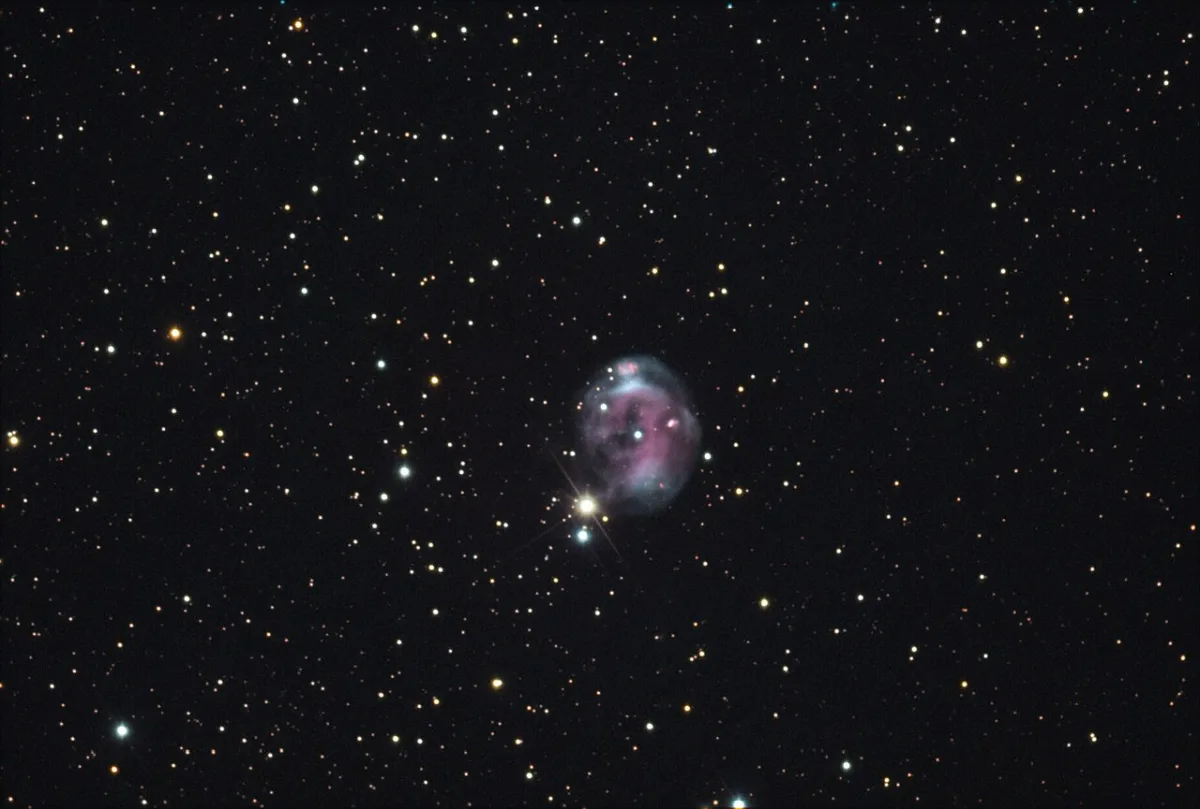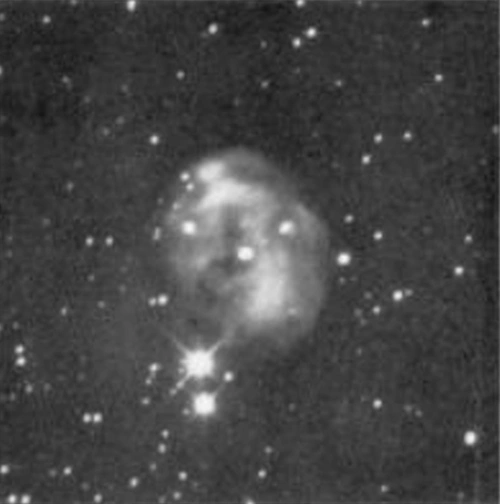The Fetus Nebula is a planetary nebula located approximately 2,800 light-years away in the constellation Cygnus. With an apparent magnitude of 12.0 and an apparent size of 1.4 by 1.1 arcminutes, it can be spotted in small telescopes. The nebula is listed as NGC 7008 in the New General Catalogue.
The Fetus Nebula has a diameter of around 1 light year, which is comparable to the size of the solar system. The nebula’s intricate curved shape in photographs earned it its popular nickname. NGC 7008 is included in the Herschel 400 catalogue of objects that can be observed in amateur telescopes.
The nebula formed around 5,700 years ago, when an evolved red giant star expelled its outer layers in the late stages of its evolutionary cycle. As the clouds of expelled material expand away from the central star, they are ionized by the intense ultraviolet light of the hot exposed stellar core. The outermost layers of the nebula are composed of material expelled during an earlier phase of the star’s life, when it was a pulsating red giant on the asymptotic giant branch (AGB). In this phase, the star was experiencing accelerated mass loss though a strong stellar wind.

Fetus Nebula (NGC 7008), image credit: Dietmar Hager, Don Goldman and Paul Mortfield (PD)
The relatively bright central star of NGC 7008 has an apparent magnitude of 13.2. It is a hot star with the spectral type O7. It has a mass of around 0.55 solar masses and a luminosity about 1,300 times that of the Sun, with a surface temperature of 97,000 K.
The Fetus Nebula has an unusual overall shape. It contains two separate shells of gas, one within the other. Astronomers have offered several possible explanations for this. One, the nebula may have a binary central star and may have formed when two components of the binary system went through the AGB phase one after the other.
Another possible explanation would be that the nebula’s morphology is the result of interaction between the expanding shell of gas and planetary material orbiting the central star. Any planets or brown dwarfs orbiting the star would have been absorbed and destroyed when the star expanded into a red giant and entered the AGB phase.

Sometimes nicknamed the Fetus, this planetary nebula is located about 2800 light-years away in the constellation Cygnus the Swan. This image was taken as part of Advanced Observing Program (AOP) program at Kitt Peak Visitor Center during 2014. Image credit: KPNO/NOIRLab/NSF/AURA/Donn and Aaron Starkey/Adam Block (CC BY 4.0)
Facts
NGC 7008 was discovered by the German-born British astronomer William Herschel with his 18.7-inch reflector telescope on October 14, 1787. Herschel spotted the nebula from Slough, England, and included it in his catalogue as H I 192, describing it as “considerably bright of irregular figure, 3′ long, 2.5′ broad nebulosity.”
The Fetus Nebula was one of the planetary nebulae imaged by the American astronomer Francis G. Pease with the 60-inch f/5 reflector at Mount Wilson Observatory in California between 1911 and 1916. Pease photographed the nebula on July 22, 1914, and noted, “This planetary nebula is elliptical in shape, 95″x75″, p=5°, containing much detail. The strongest bits of nebulosity are two condensations just E of the N end of the major axis. On the south following side the elliptical form seems eaten away, but traces of nebulosity may be seen connecting with a star which lies p=156°. A number of stars a magnitude or two fainter than the nucleus appear in the nebula. Except for one, they are surrounded by a dark ring which in turn opens directly on a dark region. As the nucleus itself presents this appearance, it is suggested that these stars lie within the nebula.”

NGC 7008 imaged by Francis Pease (PD)
Location
The Fetus Nebula lies in the northern part of Cygnus, near the border with Cepheus. It appears a little more than halfway from Deneb, the brightest star in Cygnus, to Alderamin, the luminary of Cepheus. It can be found close to the intersection of the imaginary lines connecting Deneb with Alderamin and Fawaris with Zeta Cephei.
Deneb is easy to identify because it is part of the Northern Cross, a prominent northern asterism formed by the brightest stars in Cygnus. Alderamin lies along the imaginary line drawn from Schedar through Caph in Cassiopeia’s W.
The planetary nebula NGC 7008 can be spotted in 6-inch telescopes but is best observed in larger instruments at high magnification, with OIII filters. It appears between two dark nebulae, catalogued as Lynds 1029 (LDN 1029) and Barnard 357 (B357).
At declination +54° 32′, the Fetus Nebula is best seen from the northern hemisphere. It never climbs above the horizon for observers south of the latitude 35° S.
The best time of the year to observe NGC 7008 and other deep sky objects in Cygnus is during the month of September, when the constellation appears high above the horizon in the early evening.

Location of NGC 7008 (the Fetus Nebula), image: Stellarium
Fetus Nebula – NGC 7008
| Constellation | Cygnus |
| Object type | Planetary nebula |
| Right ascension | 21h 00m 32.817600s |
| Declination | +54° 32′ 35.37600″ |
| Apparent magnitude | 12.0 |
| Absolute magnitude | 12.0 |
| Apparent size | 1.4′ x 1.1′ |
| Distance | 2,800 light-years (858 parsecs) |
| Radius | 0.5 light years |
| Names and designations | Fetus Nebula, Foetus Nebula, NGC 7008, PK 93+5.2, PN VV 258, PN VV’ 540, PN ARO 39, PK 093+05 1, PK 093+05 2, PN K 4-44, PN G093.4+05.4, BWE 2059+5420, CSI+53 2533 3, TIC 421550108, UCAC4 723-077659, WB 2059+5420, WEB 18870, GALEX J210032.6+543236, GALEX J210032.9+543236, GB6 B2059+5420, 87GB 205905.4+542039, GSC 03956-00738, IRAS 20590+5420, Lan 111, 2MASS J21003279+5432352, PLX 5049.00, NVSS J210032+543239, WN B2059.0+5420, WISE J210032.81+543235.4, WISEA J210032.64+543235.5 |

NGC 7008, image credit: Adam Block/Mount Lemmon SkyCenter/University of Arizona (CC BY-SA 4.0)